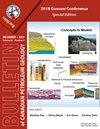Characterization, architecture and controls of Cold Lake marginal-marine oil sands: the Grand Rapids Formation (Upper Mannville) of east-central Alberta, Canada
Q3 Earth and Planetary Sciences
引用次数: 5
Abstract
Abstract Hydrocarbons have been produced from the Grand Rapids oil sands for decades; however, large volumes still remain in place, mostly due to the extreme complexity of the reservoirs. Detailed examination of wireline logs and cores from 1127 wells within the 400 km2 Manatokan Field (Twp 62–63; Rge 4–5 W4M) are used to characterize the deposits, define the stratigraphic framework, establish the depositional architecture, and infer the mechanisms and parameters controlling the deposition of the formation. Twenty-one facies are identified based on detailed core analysis (sedimentology, ichnology, geochemistry), and are organized into five recurring facies associations: 1) wave-dominated shoreface deposits; 2) delta-influenced shoreface deposits; 3) interdistributary bay deposits; 4) marine-influenced fluvial deposits; and 5) coastal plain deposits. Shoreface deposits, which form correlatable 3–30 m-thick coarsening-up cycles, are classified as wave-dominated fluvial-influenced to fluvial-dominated wave-influenced, potentially tide-affected (Wft to Fwt). Marine-influenced fluvial deposits are mostly emplaced as point bars within 100–2000 m wide and 3–30 m deep fluvial bodies distributed within the strata. The established stratigraphic framework subdivides the formation into 11 parasequences, 7 parasequence sets, 7 stratigraphic levels containing fluvial bodies and 2 depositional sequences capped by sequence boundaries. Those observations contrast with previous interpretations that recognized seven sequences boundaries capping each of the parasequence sets. However, stratigraphy of the Grand Rapids Formation is primarily controlled by eustacy: sequences and parasequence sets are primarily influenced by long-period moderate-amplitude (1.2–2.4 m.y.; 15–30 m) and short-period low-amplitude (0.4 m.y.; <10 m) glacio-eustatic sea-level cyclicity, respectively. Individual parasequences are likely controlled by short-period allocyclic (100 to 20 kyr climatic variations) and/or autocyclic parameters (delta lobe switching every 5 to 2 kyr) that affect regional and local sediment flux. These parameters and different timescales explain the peculiar distribution of reservoirs in the field with small and isolated geobodies.加拿大阿尔伯塔中东部的大急流组(Upper Mannville)冷湖边缘海洋油砂的特征、结构和控制
几十年来,人们一直从大急流城的油砂中开采碳氢化合物;然而,由于储层的极端复杂性,仍有大量储层存在。详细检查了Manatokan油田400平方公里范围内1127口井的电缆测井和岩心(Twp 62-63;Rge 4 ~ 5 W4M)对沉积进行了表征,明确了地层格架,建立了沉积构型,推断了控制地层沉积的机制和参数。根据详细的岩心分析(沉积学、技术和地球化学),确定了21个相,并将其分为5个反复出现的相组:1)波浪型滨面沉积;2)三角洲影响的滨面沉积;3)分流间湾沉积;4)海相河流沉积;5)沿海平原沉积物。岸面沉积形成3 ~ 30 m厚的相关粗化旋回,可分为波浪主导的河流影响型到河流主导的波浪影响型和潜在的潮汐影响型(Wft ~ Fwt)。海相河流沉积多为点坝,分布在100 ~ 2000 m宽、3 ~ 30 m深的地层内。已建立的地层格架将该组划分为11个准层序、7个准层序套、7个含河体的地层水平和2个层序边界覆盖的沉积层序。这些观察结果与之前的解释形成了对比,之前的解释认为每个准层序集都有7个层序边界。然而,大急流组的地层学主要受升水控制,层序和准层序集主要受长周期中振幅(1.2-2.4 m.y;15-30 m)和短周期低振幅(0.4 m.y;<10 m),分别为冰川-海平面上升周期。个别副层序可能受影响区域和局部沉积物通量的短周期非旋回(100至20 kyr的气候变化)和/或自旋回参数(每5至2 kyr的三角洲瓣转换)控制。这些参数和不同的时间尺度解释了在小而孤立的地质体中储层的特殊分布。
本文章由计算机程序翻译,如有差异,请以英文原文为准。
求助全文
约1分钟内获得全文
求助全文
来源期刊

Bullentin of Canadian Petroleum Geology
Earth and Planetary Sciences-Geochemistry and Petrology
CiteScore
2.50
自引率
0.00%
发文量
0
期刊介绍:
The Bulletin of Canadian Petroleum Geology is a peer-reviewed scientific journal published four times a year. Founded in 1953, the BCPG aims to be the journal of record for papers dealing with all aspects of petroleum geology, broadly conceived, with a particularly (though not exclusively) Canadian focus. International submissions are encouraged, especially where a connection can be made to Canadian examples.
 求助内容:
求助内容: 应助结果提醒方式:
应助结果提醒方式:


